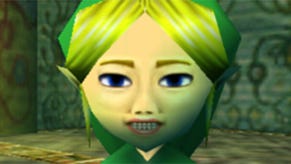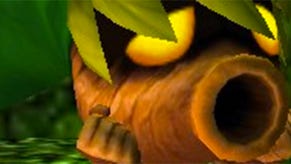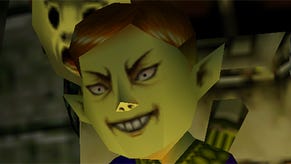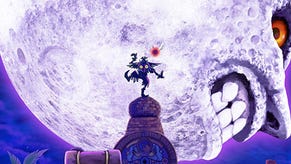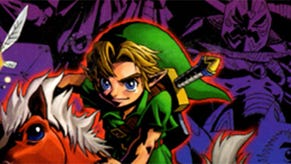USgamer Club: The Legend of Zelda: Majora's Mask 3D Part 2 — Face/Off
This week, Bob plumbs the depths of the Snowhead and Great Bay Temples. Join in on the discussion!
This article first appeared on USgamer, a partner publication of VG247. Some content, such as this article, has been migrated to VG247 for posterity after USgamer's closure - but it has not been edited or further vetted by the VG247 team.
Hello again, and welcome to another edition of USgamer Club! As with Kat's approach to Suikoden II, I'll be asking for and responding to your comments as we play through the entirety of The Legend of Zelda: Majora's Mask 3D. And while I'd like to hear what you have to say about this portion of the game, be sure to also leave your thoughts on the next chunk of Majora's Mask in the comments section of this article. In Part 3, we'll be wrapping everything up with a discussion of the remainder of the game, so be sure to contribute by Sunday, March 8!
[Note: For the sake of convenience, the images in this article are from the original N64 version of Majora's Mask. (Courtesy of Zeldapedia.)]
With the addition of a bow to Link's arsenal—picked up in Woodfall Temple—his utility increases significantly. And that's just one of the things that makes Majora's Mask unique: Instead of filling its dungeons with Link's standard tools, the main treasure in each one comes in the form of a different type of arrow.
Still, there's bound to be some familiarity with a game that leans so heavily on another for inspiration. Like Ocarina, Majora's segregates (in the non-ugly way) its races to their appropriate locations: Gorons to the mountains, Zoras to the sea. This time around, though, their habitats are distillations of what you'd find in the previous game. The Gorons and Zoras are limited to a Shrine and a Hall, respectively, which raises the question: Just where did everyone go? Did the environmental changes wipe a significant portion of their numbers out, or did most of them flee in the manner of Clock Town's residents?
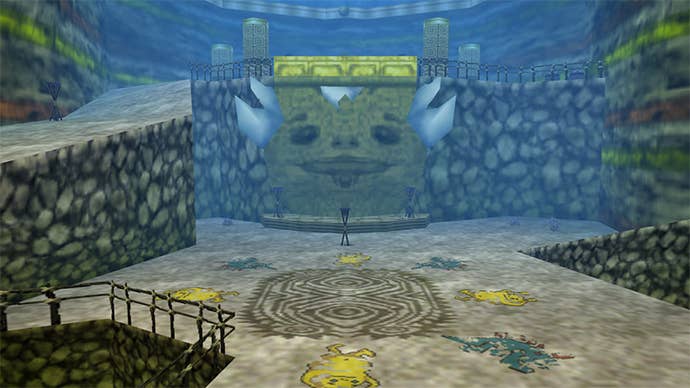
Whatever the case, the Goron Mask is one of the most useful items in a Zelda game, simply for how fast it lets you zip around the landscape while tearing up any items or shrubbery in your path. Majora's also provides Epona for basically the same function, but I rarely use her outside of the few times it's necessary; turning into a rolling ball of death is just so much more immediate. And the Snowhead Temple provides plenty of chances to try out your new Goron abilities, even though, like the Woodfall Temple, it's not all that expansive. Instead, the dungeon layout focuses on verticality, and operates around a central hub with rooms blossoming out from the center—a trend we'll definitely see again. And, this time around, the stray fairies are hidden much more covertly: You'll have to use the Lens of Truth to find them all—a fact the game doesn't even try to communicate. Some visual hints exist that help point out these hidden alcoves, but unless you know to look for them, they can easily pass you by.
Goht definitely stands as the best boss fight in Majora's, and one of the greatest overall in a 3D Zelda game. This encounter diverges from the standard formula and instead takes the form of a race (of sorts) where you have to keep up with the boss while ramming him and avoiding the rocks he kicks up and bombs he literally poops out—that's what it looks like to me, anyway. This version of Majora's tweaks the fight a bit, as expected; once you knock him over, one of those creepy Majora's eyes reveals itself as a weak point, which Link can then attack with the weapon of his choice—though fire arrows make the most sense. (Is it just me, or are Zelda games rife with severe ocular damage?) Goht goes down pretty easy, but, like the N64 version, it's one of the most satisfying boss battles of the game.
Before you can move on to the Great Bay and the next Temple, you first need to visit the Romani Ranch—after thawing out Snowhead and taking the Big Goron's bomb-handling test, Link can open the way to this area on the first day instead of the last. And while you can grab Epona and jet, I always take this time to wrap up the few quests related to Romani and Cremia, the two sisters who take care of the place. This is where one of the more infamous parts of Majora's Mask pops up—even if you've never played the game, you've probably heard about the whole "aliens abducting cows" thing. Agree to save Romani's bovine population, and you'll take part in a sort of tower defense mini-game that has you riding horseback and wiping out strange ghosts that have their hearts set on cow-napping them. This is where the added friendliness of the 3DS version really pays off; if you screwed up this quest in the N64 version, you'd have to play the Song of Time and go through the whole process again. Now, you can just save before the event, and restart from there if you can't save the cows. Having finished Majora's three times in my life, I didn't feel particularly guilty for doing this.
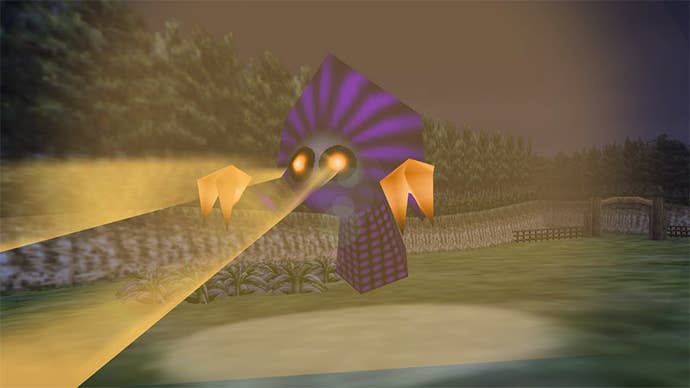
After this, you can go ahead with the second part of this quest, which involves escorting Romani's supply of delicious (and possibly alcoholic) milk to Clock Town. You'll have to fight off the Gorman Brothers—disguised as Garo ninja in order to hide the fact that they're really Evil Luigis—but, in doing so, you'll earn the Romani Mask, which grants you access to Clock Town's Milk Bar, where Gorman goes every night to get tipsy on dairy products. Doing these quests also unlocks some of the most depressing dialogue in the game; talk to Cremia at Romani Ranch on the last day, and she'll admit she knows everyone is doomed, even if they're coming to take refuge there. Dark!
The Great Bay Area features the return of another element we've seen in Ocarina: stealth! Though, this time around, it's much more manageable. While the 3DS version moves the Stone Mask to a place that requires at least some engagement with stealth gameplay, after you pick up this item, it's pretty easy going from there. And once you nab all of the Zora eggs from this location and the Sea Snakes' Lair, the Great Bay Temple opens itself up to you. Of course, by this point, Link has another new form: the sleek and slippery Zora, which offers the same fast travel under water as the Goron form does on terra firma. In this version, though, the controls aren't inverted by default, which confused the hell out of me at first. Maybe I'm just used to the old version, but Zora Link controlling like an Arwing feels so much better. (Thankfully, you can change this within the game.)
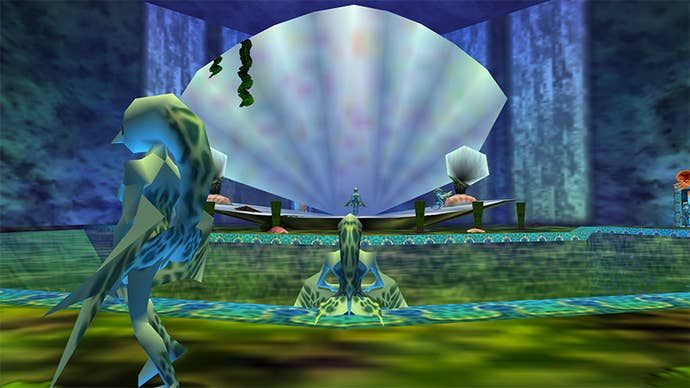
I'm sure the prospect of another water temple must have caused those who didn't like Ocarina's to break out into hives, but Majora's take on this type of dungeon is much less complicated. Instead of changing water levels, this time around, you're altering the direction of the water's flow, which isn't as tricky as it sounds. Once you change it to move the opposite direction, you'll never have to change it back, which makes navigation amount to simply heading through the passageways you haven't used before. This version of Majora's makes the Great Bay Templt a touch easier, too: the areas you're supposed to fire your arrows into the water—to make icy platforms—are now marked, eliminating any guesswork. Unfortunately, the boss remains pretty annoying (though not impossible) once you reach the second phase; I consistently found myself releasing the mines too early before he could swallow them. I'm definitely not looking forward to fighting him again when I need to for the sake of side-quests.
That's nearly it for this week's adventures, but before I go, I'd like to share one thing I noticed. While I've always known all of your forms come from masks of those who've passed away, for some reason, this time around I noticed that each of these figures died attempting what Link later accomplishes. Throughout, Link essentially borrows their identities to do what they couldn't. This makes a lot of sense in the case of Mikau (Zora) and Darmani (Goron), but I've always wondered what happened to the Deku in the prologue, where Link's Deku Mask clearly comes from. Did Skull Kid's magic snuff him out, or did he die trying to escape Termina's dimension in search of help? I'd definitely love to hear your theories.
That said, please leave your comments about this portion of Majora's Mask and the remainder of the game by Sunday, March 8th. I'm giving everyone an extra week since my bout with the flu delayed this installment by a few days, and GDC will be keeping me very busy soon. Thanks in advance, and I'll see you then!

